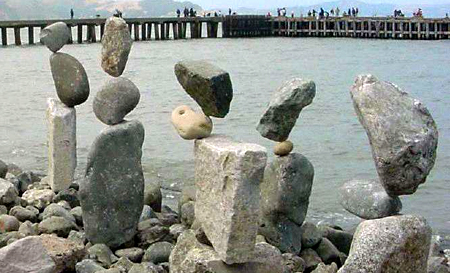 |
| Like these, only less artsy. |
This was terrible news for me because I've wanted to use an image of Adolf Hitler in this post but I can't think of how I can connect him to that topic now. But my resolve is rock-solid so I'll go on ahead and do it anyway:
 |
| "Rock-solid!" Verstehen sie? |
Glad that's out of the way. Now we can talk about other creepy, more Jew-friendly (Jew-friendlier?) things. Like Easter . . . Island. Specifically the stone statues they have over there. One such statue is seen below playing a friendly game of sensory-deprivation-tug-of-war with the locals:
| There's cautionary tale in there somewhere. |
These things are called moai, and they are part of an ancient Polynesian civilization's mythos. Unfortunately for them, what started out as adorable became the end of them all. Believe it or not, there really is a cautionary tale in there.
LA Times tells us:
"UCLA anthropologist Jared Diamond famously detailed what the called the "ecocide" of Rapa Nui in his 2005 book "Collapse." When Polynesians first settled the island about AD 800, they had the misfortune to select one that was dry, cool and remote -- and thus poorly fertilized by windblown dust or volcanic ash. They chopped down forests to provide wood for construction and for moving the moai, and the trees didn't return. The denuded landscape allowed winds to blow off the topsoil, and fertility fell sharply. When the natives no longer had wood for building fishing canoes, they killed and ate all the birds. Before the Dutch arrived at the island on Easter Sunday in 1722, the population had descended into cannibalism and barbarity. Diamond called it "the clearest example of a society that destroyed itself by over-exploiting its own resources."
However, archaeologists Carl Lipo of Cal State Long Beach and Terry Hunt of the University of Hawaii argue that the moai-dragging peoples were not stupid:
Shows what happens when humans tip the delicate balance that keeps nature alive: whoever does the tipping dies. Except Michael Jackson. He can tip any balance he wants, he can make gravity his little bitch, but he's not. Gonna. Oh. What am I talking about? See, in my absence, my teacher also played a "rock song" at the AVP. I've no idea what song it was, but I do know it's a pun. Because it's a song. About rocks.
He apparently enjoyed it so I can only assume it was as good (and hopefully less apelike) as this:
I promise to be less of a slob next week.
Sources:
http://www.latimes.com/news/science/sciencenow/la-sci-sn-stoneheads-easter-island-20120620,0,6247582.story
". . .the stones could be "walked" by as few as 18 people with ropes by tilting them back and forth on their bases. That version jibes well with the islanders' own mythology, which claims that the moai walked across the island."And also:
"The first inhabitants dined on the rats, but the animals had no other natural predators and overran the island. Buried nuts from the extinct Easter Island palms show distinctive teethmarks from the rats. They probably also ate birds' eggs. With the rats eating the palm nuts, the trees could not be reseeded naturally ."Fine. They were stupid.
Shows what happens when humans tip the delicate balance that keeps nature alive: whoever does the tipping dies. Except Michael Jackson. He can tip any balance he wants, he can make gravity his little bitch, but he's not. Gonna. Oh. What am I talking about? See, in my absence, my teacher also played a "rock song" at the AVP. I've no idea what song it was, but I do know it's a pun. Because it's a song. About rocks.
He apparently enjoyed it so I can only assume it was as good (and hopefully less apelike) as this:
I promise to be less of a slob next week.
Sources:
http://www.latimes.com/news/science/sciencenow/la-sci-sn-stoneheads-easter-island-20120620,0,6247582.story
Photo courtesy:




